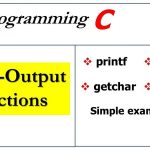The C programming language provides a keyword called typedef, which you can use to give a type, a new name. Following is an example to define a term BYTE for one-byte numbers −
typedef unsigned char BYTE;
After this type definition, the identifier BYTE can be used as an abbreviation for the type unsigned char, for example..
BYTE b1, b2;
By convention, uppercase letters are used for these definitions to remind the user that the type name is really a symbolic abbreviation, but you can use lowercase, as follows −
typedef unsigned char byte;
You can use typedef to give a name to your user defined data types as well. For example, you can use typedef with structure to define a new data type and then use that data type to define structure variables directly as follows −
#include<stdio.h>
#include<string.h>
typedefstructBooks{
char title[50];
char author[50];
char subject[100];
int book_id;
}Book;
int main(){
Book book;
strcpy( book.title,”C Programming”);
strcpy( book.author,”Vishwa Prabhu”);
strcpy( book.subject,”C Programming Softecks”);
book.book_id =123456;
printf(“Book title : %s\n”, book.title);
printf(“Book author : %s\n”, book.author);
printf(“Book subject : %s\n”, book.subject);
printf(“Book book_id : %d\n”, book.book_id);
return0;
}
When the above code is compiled and executed, it produces the following result −
Book title : C Programming
Book author : Vishwa Prabhu
Book subject : C Programming Softecks
Book book_id : 123456
typedef vs #define
#define is a C-directive which is also used to define the aliases for various data types similar to typedef but with the following differences −
· typedef is limited to giving symbolic names to types only where as #define can be used to define alias for values as well, q., you can define 1 as ONE etc.
· typedef interpretation is performed by the compiler whereas #define statements are processed by the pre-processor.
The following example shows how to use #define in a program −
#include<stdio.h>
#defineTRUE 1
#define FALSE 0
int main(){
printf(“Value of TRUE : %d\n”, TRUE);
printf(“Value of FALSE : %d\n”, FALSE);
return0;
}
When the above code is compiled and executed, it produces the following result −
Value of TRUE : 1
Value of FALSE : 0


